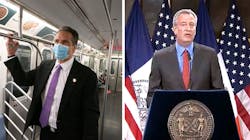Who really controls the New York Metropolitan Transportation Authority?
Due to the ongoing feud between New York Gov. Andrew Cuomo and New York City Mayor Bill de Blasio, NYC subway and bus riders continue to be the losers. The New York Metropolitan Transportation Authority (MTA) Board is made up of 17 voting members. Their votes impact how the $51 billion MTA 2020 - 2024 Five Year Capital Program spending priorities, contract awards, fares and service operations are determined. This effects millions of New Yorkers who ride NYC Transit bus, subway, Staten Island Railway, MTA bus, Long Island and Metro-North railroads.
Gov. Cuomo nominates six of those board members. He names the board chair and CEO. In reality, he controls the MTA. Mayor de Blasio nominates four. Suburban county executives from Nassau, Suffolk, Westchester, Dutchess, Orange, Rockland and Putnam each nominate one. Westchester, Dutchess, Orange and Rockland share one vote.
NYC currently has only two of its four votes due to two vacancies. Ms. Veronica Vanterpool and Mr. Carl Weisbrod resigned earlier this year. Mayor de Blasio nominated NYC Department of Aging Commissioner Ms. Lorraine Cortés-Vázquez to replace Weisbrod and NYC Mayor's Office for People with Disabilities Mr. Victor Calise to replace Vanterpool.
Why did Gov. Cuomo sit on Mayor de Blasio's two nominations for months before allowing them to go forward just days ago? NYC deserves four full-time votes on the MTA Board. Gov. Cuomo continues to live by the old Sicilian proverb, "vengeance is a dish best served cold." As a result of his inaction, eight million NYC residents were left out in the rain for months when it comes to MTA management.
Gov. Cuomo and Mayor de Blasio have a lot in common with the late New York Republican Governors Nelson Rockefeller (1959 - 1974) and NYC Mayor John Lindsay (1966 - 1973) along with Governor George Pataki (1995 -2006) and NYC Mayor Rudy Giuliani (1994 - 2001). The same is true for the late Democrat Governor Hugh Carey (1975 - 1982), Mario Cuomo (1983 - 1992) and NYC Mayor Ed Koch (1978-1988). Nelson Rockefeller, George Pataki, Hugh Carey, Mario Cuomo and son Andrew Cuomo deal with mayors who want equal billing on the political marque. Lindsay's urban, Koch's Big Apple, Giuliani's safety/quality of life and de Blasio's progressive agenda is dependent upon both increased state and federal assistance. Mayor de Blasio envisioned himself as the national spokesperson for progressive mayors from all cities. Gov. Cuomo believes he is a national spokesperson for progressive governors for all states. Both harbor future political ambitions to hold higher elective office.
Mayor de Blasio has the nuclear transit option when it comes to regaining control of NYC Transit bus and subway systems from Gov. Cuomo. Within the 1953 master agreement between the city of New York and NYC Transit is an escape clause. At any time, NYC has the legal right to take back at any time control of its assets. This includes the subway and bus system. In 1953, the old NYC Board of Transportation passed on control of the municipal subway system, including all its assets under a master lease and operating agreement to the newly created NYC Transit Authority.
The master lease and operating agreement was subsequently amended over time to include various NYC private franchised bus operators and former B&O Railroad-owned Staten Island Rapid Transit Railway Company.
In 1971, the passenger operations of the former B&O Railroad-owned Staten Island Rapid Transit Railway Company were sold to NYC for $3.5 million. Later that year, NYC passed on control to the Metropolitan Transportation Authority. The MTA created a subsidiary, the Staten Island Rapid Transit Operating Authority. It is managed by the MTA NYC Transit's Department of Subways and Staten Island railway.
In 2005, NYC transferred management of the seven private franchised bus operators (Command Bus, Green Lines, Jamaica Bus, Triboro Coach, Queens Surface, NY Bus and Liberty Lines Bronx Express) under the NYC Department of Transportation to the MTA. The MTA subsequently created MTA Bus, which is separate from NYC Transit and Manhattan Bronx Surface Bus operations.
Regaining total control comes with a number of financial liabilities. City Hall will have to negotiate with both the governor and State Legislature over how much of the MTA's $40 billion long-term debt and billions more in employee pension, health insurance and other liabilities come with the package. NYC would also inherit a series of union contracts and work rule agreements. The city would need to develop a plan for turning over management for billions in hundreds of ongoing capital improvement projects that are already under way. Don't forget current purchases for several thousand new subway cars and buses. A significant portion of the $12 billion for capital funded projects contained dozens of grants from the Federal Transit Administration that would have to be transferred from MTA to NYC. This would involve the de-obligation and re-obligation of funding contained in active grants from MTA to NYC. There would also have to be an update to the MTA Federal Transit Administration Bi Annual Certification for thousands of federally funded assets currently being maintained by the MTA to NYC. This document is submitted every two years and certifies that any asset worth over $5,000 is being properly maintained and remains in active transit service. All of these assets have to meet their promised useful life.
NYC Transit bus and subway are the largest transit operators in the nation with a fleet of 6,400 subways and 4,400 buses. With a fleet of 1,300 buses, MTA bus is one of the top 10 bus operators in the nation. It is the equivalent of attempting to manage a fortune five hundred corporation. Does NYC have the technical capacity to take on such an undertaking to support creation of the new 'Big Apple Transit'? Today's New York City Department of Transportation (DOT) technical capacity as it relates to subways and buses is weak. It is primarily in the management of bus lanes, bus shelters, bus stop signs, select bus service, bus priority signalization, bike lanes, pedestrian plazas and street calming projects.
Perhaps NYC should take it one step at a time. Try attempting to manage the Staten Island Rail Road. It is a simple subway on the ground consisting of 21 stations. This two track route runs on Staten Island south shore from Tottenville to St. George. Most riders transfer to the NYC DOT Staten Island Ferry which connects the St. George and Whitehall Street Manhattan Ferry Terminals. Staten Island is one of only five boroughs in NYC without a direct subway connection to Manhattan.
Regain control of the 1,300 MTA Bus fleet. After developing technical capacity to run these two, next try running the #7 subway line. The Flushing Queens #7 subway has its own stand alone fleet and yard which makes it the perfect candidate. NYC should first attempt to successfully mange all three over a five year test period. If successful, perhaps then initiate a serious discussion about regaining control of the other 95 percent of NYC Transit subway and bus assets.
-----------------------------------------------------------

Larry Penner
Larry Penner is a transportation advocate, historian and writer who previously served as a former director for the Federal Transit Administration Region 2 New York Office of Operations and Program Management. This included the development, review, approval and oversight for billions in capital projects and programs for New Jersey Transit, New York Metropolitan Transportation Authority, NYC Transit bus, subway and Staten Island Railway, Long Island and Metro North railroads, MTA Bus, NYCDOT Staten Island Ferry along with 30 other transit agencies in New York and New Jersey.



